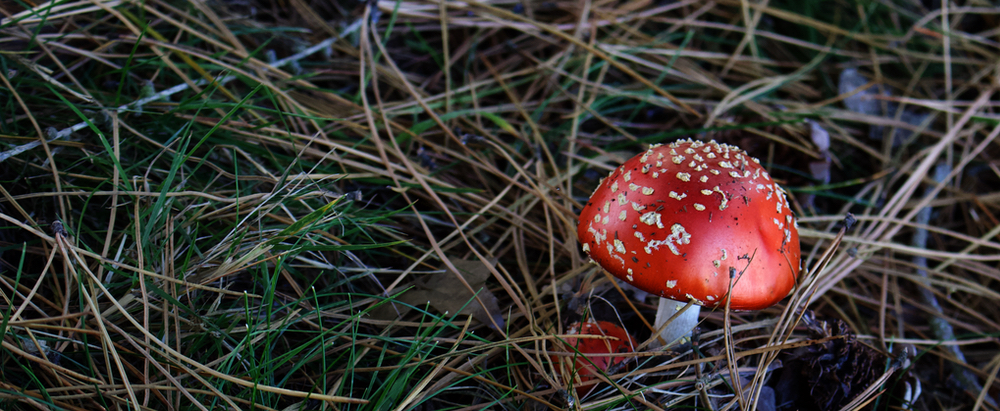
Floret Flower Farm and Other Seeds from Emerden Flowers
Hello friends,
I was doom scrolling on Instagram a couple of weeks ago, and came across a post by Emerden Flowers announcing they were collaborating with Floret Flower Farm in the USA, and they were bringing Floret and Dawn Creek Zinnias and Dahlias into New Zealand.
Before you could blink an eye, I had zoomed over to Emerden Flowers website, and excitedly perused the pre-order links to the Zinnias and Dahlia seed mixes. I've followed Floret Flower Farm for years, and even have a couple of their books. Their book "Discovering Dahlias" is my bible when it comes to Dahlias. I was so excited, even with the very high prices of the seed packets. Now was my chance to get some seeds, and I wasn't going to miss out. I still had money budgeted for our backyard garden project, and had no problem in justifying buying 3 seed packets to hubby, along with some other seed packets from Emerden Flowers I had been wanting.
First up was choosing a Dahlia seed mix, I finally settled on choosing Floret Original Bee's Choice flower seed packet, as I want to encourage bees into my garden. Choosing two zinnia packets was more fraught with danger. After angsting over it for days leading up to when they went on sale, including spending way too much time on Instagram looking at people's photos of the various zinnia mixes, late on the Saturday night I chose Floret Original Precious Metals zinnias, and also Dawn Creek Blush zinnias, as they are colours that will fit in well in my backyard (as well as my front yard). I had also chosen a bunch of very cool Emerden flower seed packets, as some of them were on my list of plants to get for a while.
On the Sunday morning when the seed packets went on sale, I had all of the internet tabs open on the seeds I wanted, and I'd logged into Emerden Flowers website. In the minutes before 10 am I added all the Emerden Flowers into the web cart, and waited impatiently for 10 am. As soon as it hit 10 am, I reloaded the web pages for the Floret and Dawn Creek varieties I wanted, and added them to the cart. Once I was sure I got everything, I checked out, and bought it with my credit card.
It took a while before I got the confirmation email from Emerden Flowers, and then I started happy dancing.
Within a couple of days my precious seeds were delivered to my door, and it was time to fawn all over my pretty new seed packets.

The packaging for the Floret Flower Farm part of the order was stunning, and I really loved the included growing guide.
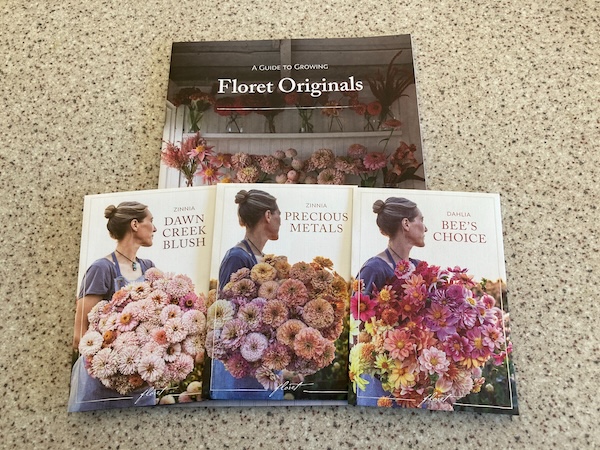
I also bought a range of Emerden flower seed varieties including pansy, larkspur, floxglove, sunflowers, cosmos, calendula, and echinacea.
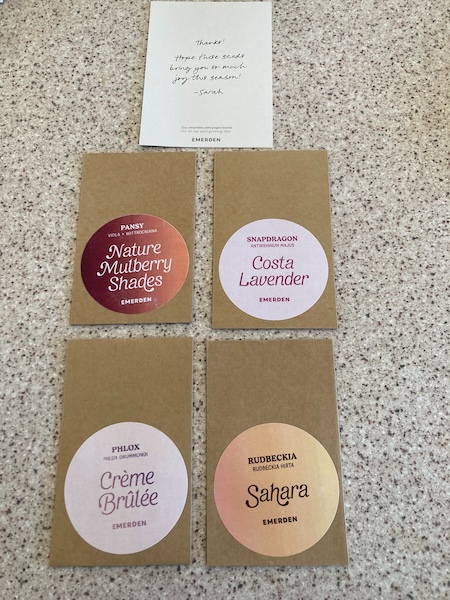
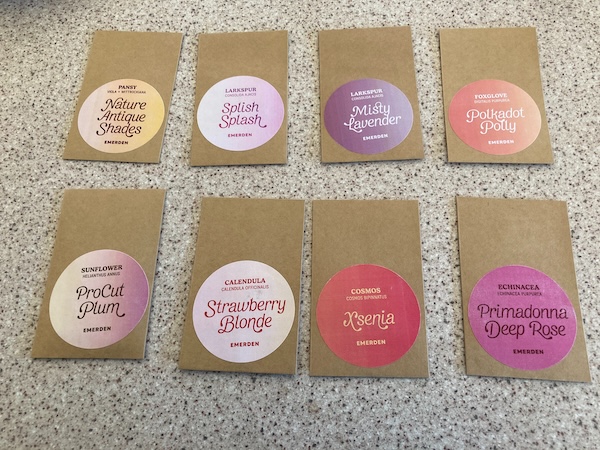
I am really excited to start planting these seeds in spring, which is less than a couple of weeks away now.
Have a wonderful day
Julie-Ann
Want to discuss my post? Feel free to chat with me on Instagram or Mastodon or Bluesky
Flower Seed Buying And My Seed Database
Hello friends,
It's that time of the year again in New Zealand, when seed companies send you tempting emails showing you the new flower seeds they have available for sale. This year two of my favorite specialist flower seed companies sent me emails in late May, so I had no choice but to peruse their wares.
The first temptation was from Susie Ripley Gardening, where I purchased Cosmos and Larkspur varieties.
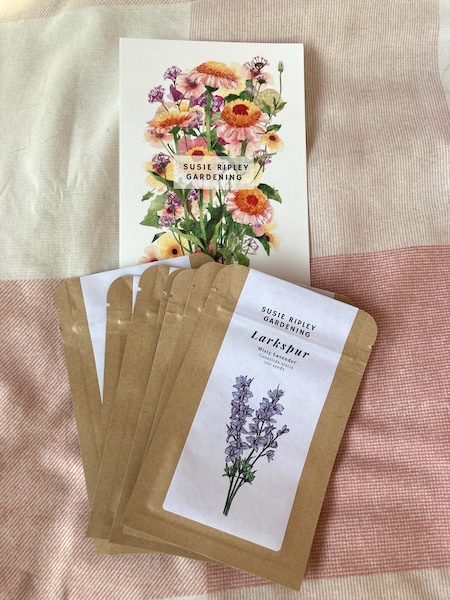
I have a soft spot for cosmos, and really fell in love with the cupcake and fizzy varieties. I can't wait to see them floating in the breeze this coming summer.
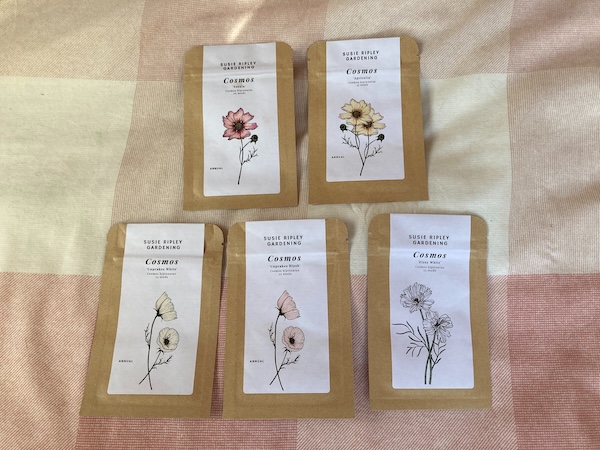
I also love how Larkspur brings some height to garden borders, so I got some purple and white varieties of that also.
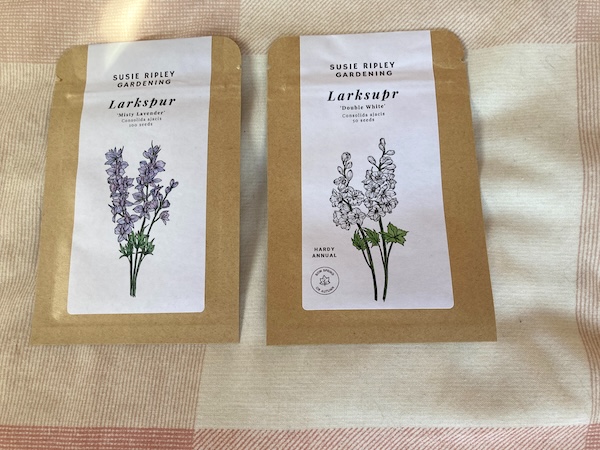
Next up was Crawford Road Gardens, where I picked up a number of seeds including aster, celosia, stock, larkspur, foxglove, scabiosa, lavender, and strawflower. My plan is to increase my garden borders in the back yard, so I picked colours that matched the seeds I bought from Susie Ripley Gardening.
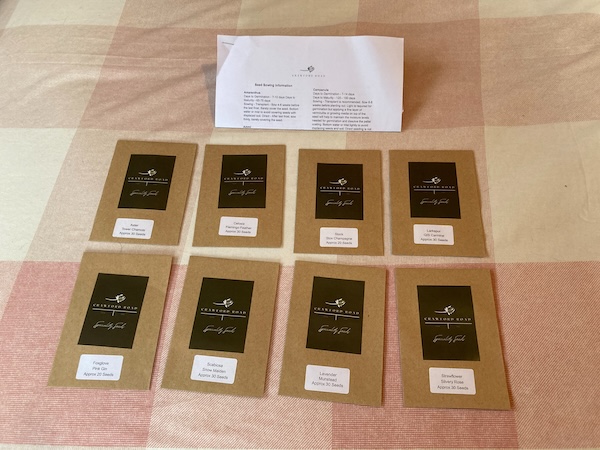
Once I had the seeds in my hot little hands, it was time to enter them into my seed database. I have a seed database set up on Libre Office, one sheet each for flower, herb, vegetable, and native seeds.

The columns are set up for seed type, supplier, sow by date, whether a seed needs to be stratified, if they've been sowed in the current year, and then which months of the year they can be sowed in.
In the rows, I have sections for each flower type e.g. Allium, Cosmos, and underneath the varieties are in alphabetical order. If the variety is greyed out, it means that I don't have that seed in stock right now. If the row is highlighted in the 2024 column, it means the seed has been sown. Cells marked in green show which months the seed can be sown in.
I really love this set up as it means that I can quickly see which seeds I need to sow, if they are still within their use by date, and if I need to reorder any seeds. I recently updated the seed database for spring 2024, so I can now see which varieties I may need to buy when the Kings Seed catalogue comes out this month. I may decide not to repurchase some seed varieties, but at least I will know which ones I've had in the past.
I have separate sheets set up for all my seed types, and it really makes seed sowing that much easier. It means that I can come up with a plan each month for seed sowing, and it also means I can purchase seed sowing mix ahead of when I need it.
It's so exciting to know that spring will soon be here, I'm already loving the return of daylight earlier and later each day. I can't wait until August when it's time to sow tomatoes and chillies.
Have a wonderful day
Julie-Ann
Want to discuss my post? Feel free to chat with me on Instagram or Mastodon or Bluesky.
Harvesting and Drying Alma Paprika
Hello friends,
This is our second year growing alma paprika plants. It's really satisfying to sow them as little tiny seeds, see them grow up into seedlings, and then onto big pepper plants with red peppers that you can dry into mild paprika.
The process for growing alma paprika plants is pretty much the same as any other capsicums or chillies. The seeds need to be sown in late winter, at the same time as tomatoes, and they need consistent steady heat in order to germinate. At that time of the year we have them sitting in the dining room where we have the fire going each day. Within a couple of weeks they germinate, and slowly over a couple of months they grow into seedlings which need to be potted on.
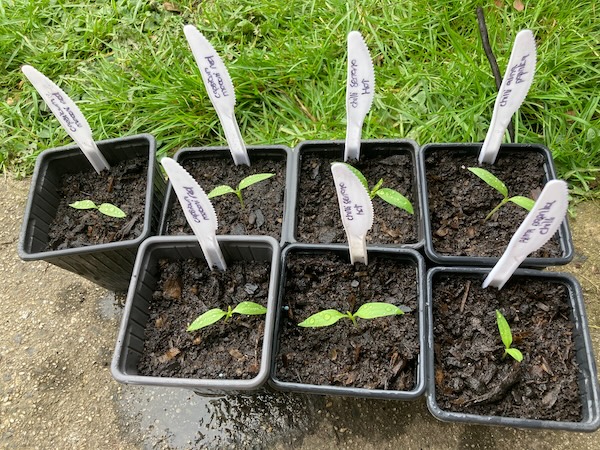
I move the alma paprika seedlings into the glasshouse in early October, and once it gets to Labour weekend, it's time to plant them into the ground in the glasshouse. Over the next few months they get bigger, and need staking, and at around Christmas they begin to flower. The rounded alma paprika fruits begin to grow, and then it's a wait over late summer and early autumn for the growing fruits to begin to change colour to a bright red hue.


Once the alma paprika fruit has turned red, it's finally time to pick them. I cut them off the plant using a pair of secateurs, and then take them into the kitchen to begin processing them.
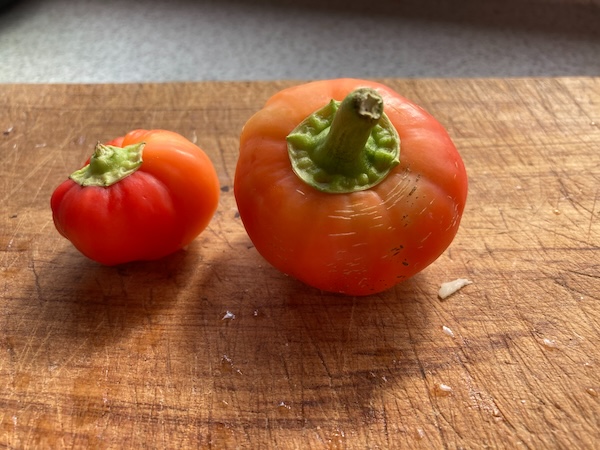
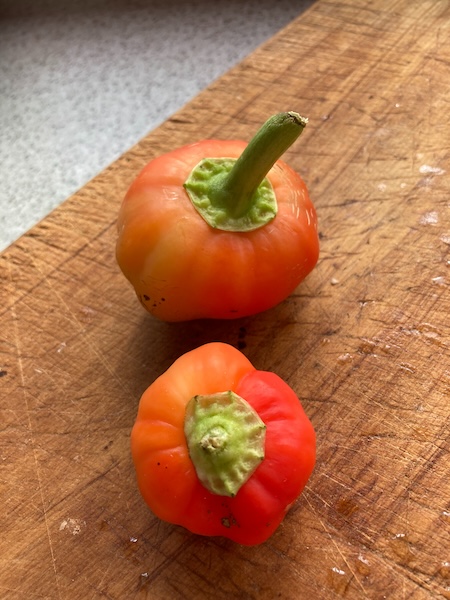
After chopping them in half, cutting off the stalks, and removing all the seeds, I slice the alma paprika fruit into thin slices and lay them out on a tray.
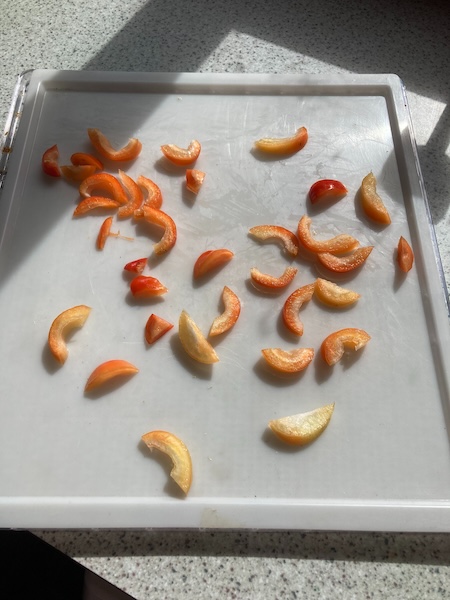
Then they go straight into the dehydrator at 35˚C, and I dry them until the slices are bone dry and brittle, ready for turning into paprika powder.
After a quick whizz in our spice grinder, the paprika powder is ready to use in cooking. The spice is tasty and mild, and works great in a number of dishes. The whole process is really easy, and satisfying, so it's now yet another yearly thing for me to do in the garden and kitchen.
Do you have any yearly tasks you enjoy? There's great satisfaction in accomplishing them when it means you have tasty food over the cold winter season.
Have a wonderful day
Julie-Ann
Want to discuss my post? Feel free to chat with me on Instagram or Mastodon or Bluesky.
Making Sugar from Homegrown Sugar Beet
Hello friends,
As you may know by now I like growing new varieties of fruits and vegetables, and the more unusual the better. Over the past couple of years I've grown Sugar Beet, with the hope to try and process my own sugar. Here in New Zealand we get all our commercial sugar from sugar cane grown in Queensland, Australia, but elsewhere in the world (including the USA) sugar is made from sugar beet.
Up until this year it was possible to buy sugar beet seeds from Kings Seeds, but they no longer sell any at this time. Sugar beet are very closely related to beetroot, and are grown in the same manner. It's best to sow them in later winter/early spring directly into the ground. Each "seed" in the packet is actually made up of 8 seeds, which grow very close to each other. After the seeds have germinated and come up from the soil, it's a good idea to pull out any that are too close together, and replant them further apart to maximise your sugar beet crop.
After that, the sugar beet plants are very easy to take care of. I watered them infrequently over the hot summer months, and come autumn, after the first frost, they're ready to harvest. As with parsnips and carrots, sugar beet are sweeter after a frost. With a garden fork it's pretty easy to pull them out of the ground. The top of the plants look like beetroot plants, and the roots of the plants look similar to parsnips.
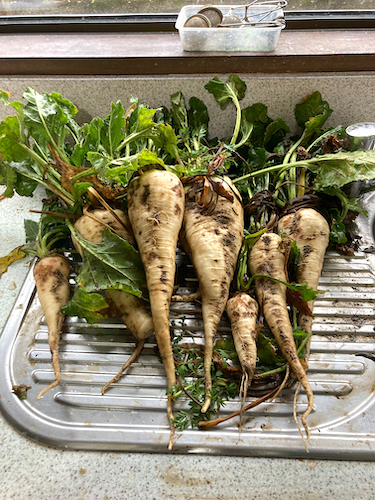
Once in the kitchen, the first step is get all the dirt off the roots by washing and scrubbing, and after that it's time to peel the sugar beet roots themselves. We just used a regular vegetable peeler, and then cut the tops off the sugar beet roots with a sharp knife.
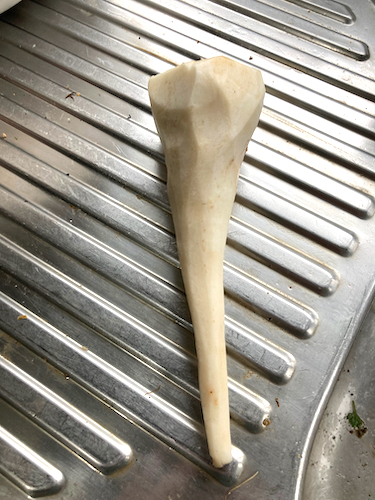
The next step is to prepare the sugar beets for grating using a food processor. We cut them into smaller chunks that would be easy to feed down the shute of the food processor. With a food processor grating the sugar beet on a rough setting took only minutes, but doing it the old fashioned way by hand took an hour (I did this in previous years). At this stage of the process we had 2 kg of sugar beet roots.
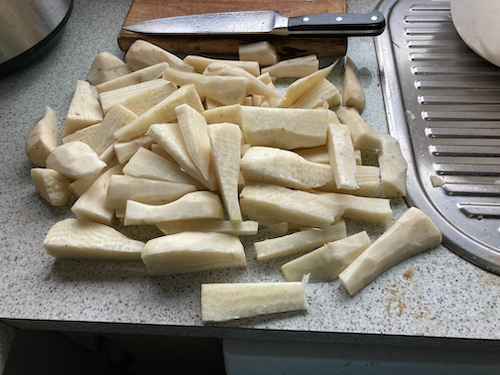

With this done, it was time to cook the sugar beet. The first year we made sugar from sugar beet we used this blog post as a guide. But this method is very labour intensive, and we burnt the sugar from the sugar beet while drying it down.
However, this year, we had a secret weapon, our brand new, handy dandy, steam juicer. Before the harvest, I had spent weeks coming up with this idea of extracting the sugar from the sugar beet using the steam juicer. Steam juicers are great for extracting juice from fruit and veges using the power of steam. You put your fruit or vegetable of interest in the top compartment of the steam juicer, add water to the bottom compartment of the steam juicer, and turn on the stove. The water heats up in the bottom compartment, and the steam rises up to the top compartment through a whole in the middle compartment. The steam cooks and softens the fruit or vegetable in the top compartment, and the cooled juice drops into the middle compartment to collect. From there, there is a spout to siphon off the collected juice at the end of the steam juicing. It's an ingenious system of juicing a big range of fruit and vegetables, and I use it a lot for making blackcurrant juice in summer, and apple juice in autumn. If you're interested in buying one in New Zealand, Netropolitan sells them infrequently when they bring them into the country. I had to wait over a year to get our one.
The steam juicer guide suggested that 1 hour of heating was good for extracting juice from beetroot, so I used that as a guide for steam juicing our grated sugar beet. The sugar beet went into the steam juicer, and an hour later the sugar beet juice had collected in the middle compartment of the steam juicer. After checking the sugar beet in the top compartment, is was soft and cooked.
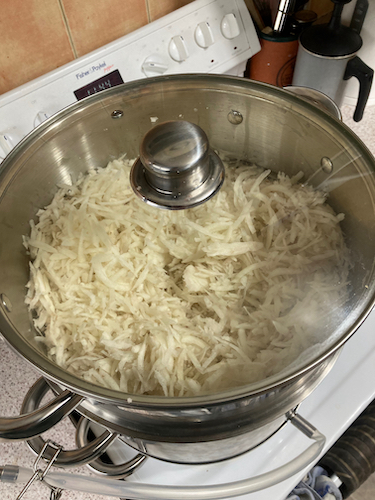
After siphoning off the sugar beet juice in the steam juicer, we filtered it through some cheese cloth to remove any solid bits of sugar beet. The left over sugar beet in the top of the steam juicer was still quite wet, so we also put that through the cheesecloth and squeezed as much juice out of it as we could get. Hubby mumbled something about getting a cider press at this point to make the job easier, but that seemed a little extreme to me...
The thing about sugar beet juice is that it isn't the nice pristine white colour you would be expecting from sugar. Normal sugar is highly processed to remove all the impurities in order to get pretty white sugar that looks the most appealing. Sugar beet juice is a brownish colour, similar to molasses, and without a centrifuge and other commercial processes, it's just not possible to get sugar that is pure white. Since we use our sugar beet sugar in baking and cooking, the brown colour doesn't bother us at all.
The next step in processing the sugar beet to get sugar, is to decrease the volume of liquid in the juice. All the sugar beet juice was transferred into a pot, and it was brought up to a simmer. The more water that comes out of the juice, the more syrupy the juice gets. You need to pay attention to it, otherwise you could remove all of the water, and burn the sugar beet molasses (I know this from experience last year).
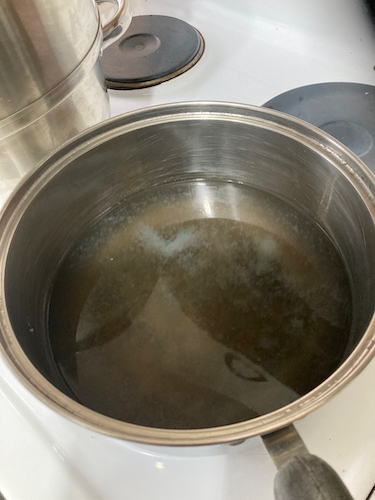
When you get the sugar syrup to a stage you are comfortable at, it's time to take it off the heat. There are two methods at this stage to remove the last of the water, either pour it into shallow trays to dry slowly over time, or bring out the dehydrator, and get it to do all the work for you in a much shorter period of time. I decided to bring out the dehydrator. The aim in the drying is to try and get sugar crystals to form, and the best way to do this is to actually seed the cooled sugar syrup with a sprinkling of sugar crystals. I haven't figured out this step totally yet, so I just got a small amount of sugar and sprinkled it on top the sugar beet syrup.
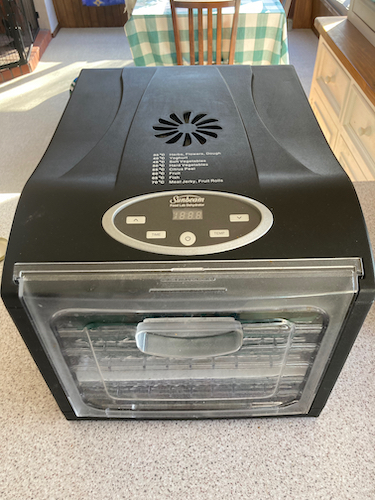
The dehydrator doesn't have an exact setting for dehydrating sugar syrup, so I chose the fruit leather setting which is set to 70˚C. The sugar syrup was poured onto dehydrator silicone sheets with a lip around the entire edge, and put into the dehydrator. After a total of 5 hours, the sugar beet sugar in the trays had dried enough to lift the sugar from the flexible silicone sheets.

The sugar was still sticky in the middle and bottom layers at this stage, so I broke the sugar up into smaller pieces and spread them out evenly over the silicone trays to dry further. After a further 5 hours, the sugar was completely dry. When broken, the sugar cracked.
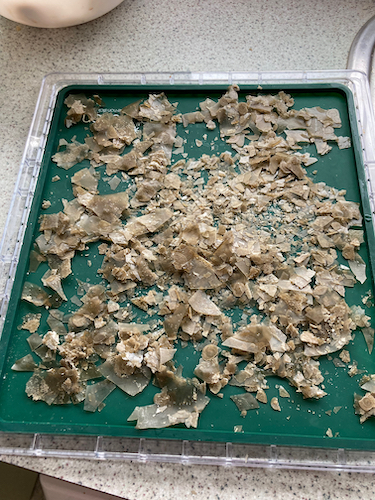
The last step in making sugar from sugar beets is to break the shards of sugar into smaller pieces. At this stage I brought out my Breville Coffee and Spice Grinder and filled it up with the sugar shards, and broke them down into smaller pieces. I use the grinder all the time to process all of our dried herbs and spices, and it has a handy removable stainless steel bowl for cleaning. It is quite often on sale, so no need to buy it at full price if you're after one for yourself.

I repeated grinding all the sugar into smaller pieces until all the sugar shards had been turned sugar.
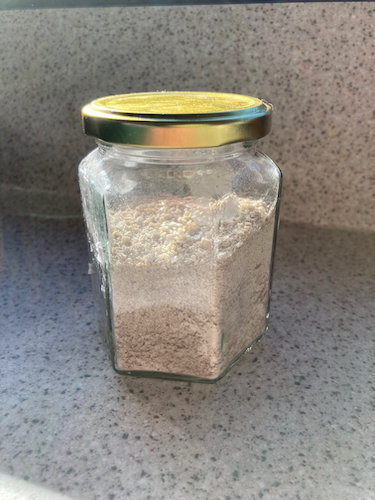
The final weight of the sugar extracted from our sugar beets was 162 grams from 2 kg of roots, which equates to a sugar content extraction of 8.1%. Sugar content extraction in sugar beets can vary anywhere from 12 - 21% according to Wikipedia using commercial processes, so I think that 8% is good for us as home growers. I think we could have gotten the number higher if we had a fruit press like hubby had mentioned, but that is a bit extreme I feel for the average home grower. The other thing to consider is when to harvest the sugar beet. Due to health issues this year, we harvested it later in the season compared to other years. It's possible that some of the sugar beet had been used up already by the plants prior to harvest.
And what does sugar beet sugar taste like? Well, it tastes like sugar, it's nice and sweet, but it has a taste reminiscent of barley sugar. Our plan is to use the sugar in baking our Christmas Cake this year. We did this last year, and no one who ate the cake noticed anything different from previous years.
As for the coming growing season, what is our plan sugar beet wise? Well thanks to some lovely people in some Facebook NZ seed swapping groups, I've been given some sugar beet seeds from their Kings Seeds packets that they still had spare in their stashes. Our plan is to grow these seeds on to develop our own big stash of sugar beet seeds for growing on in years to come. I'll also pass on some of these seeds to other people want to do the same. As sugar beet plants are biennial, it will take two seasons to happen, from there we can grow sugar beet every year and collect more seed.
I hope that you have enjoyed this in explanation of growing, harvesting, and processing of sugar beets to turn into sugar. Feel free to ask any questions on my social media about this, and I'll try to give you answers. I'm also interested if anyone has any suggestions to streamline this process any further.
Have a wonderful day
Julie-Ann
Want to discuss my post? Feel free to chat with me on Instagram or Mastodon.
The 2023 Kings Seeds Catalogue Has Arrived
Hello friends,
Down here in Dunedin, we are currently in the depth of winter. The winter solstice may have been a month ago, but now is the coldest time of the year for us, and will probably stay that way until late August at least. If it's not freezing cold and sunny, it's gray and rainy and soggy (and also still cold). Both outcomes mean not much can be done in the garden at the moment, on frosty days the ground is frozen solid, and on rainy days the garden is very squishy.
My frustration at not being able to get into the garden due to the weather has been made worse by me having minor toe surgery two weeks ago which has turned complicated thanks to an infection (as always, sigh). At the moment I can't fit my bandaged toe into any shoes (well apart from jandals), and if that wasn't bad enough, I'm not allowed to get my bandage and toe wet at all which would totally happen if I attempted to wear jandals in the garden right now. This pretty much means I have been confined to inside my home since the surgery, well apart from when I have to go to the doctors to get my dressing changed.
Just when I began to feel a little down about all this, one of the most exciting gardening days of the year happened, the arrival of the 2023/2024 Kings Seeds Catalogue. There's nothing like ripping open the packaging, sniffing that new magazine smell, and then flipping through the pages to see what seed goodies are available this year.


The first responsible thing to do though is to go through my current flower, herb and vegetable seed stashes and see what I have, there's no point in buying seed when I have plenty stored away already. My seed stashes are split into three sections, flowers, herbs, and vegetables. The flowers and herbs seeds are in disorganized chaos inside some plastic tubs.


The vegetable seeds however are meticulously organized in a craft storage box from Spotlight. It has lots of small containers which I use to separate the vegetable seeds based on each vegetable type. And thanks to my handy dandy label maker I know exactly which container is which. I also use the coloured boxes to match each vegetable type, and this makes it super easy to find the corn and carrot boxes for example.
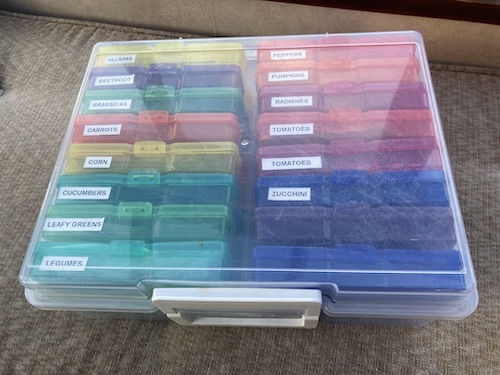

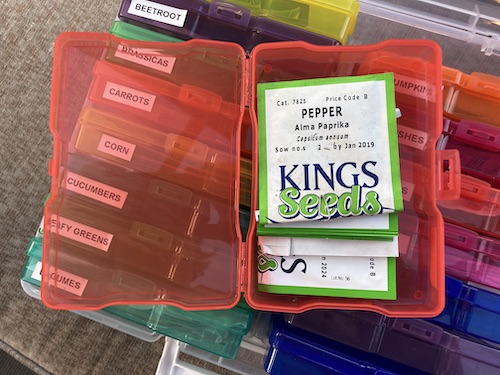
After I pull out each box I open my garden seed database and check each seed packet, and their use by date, and update the database accordingly. If any seeds are low, or finished, I highlight the database to show which seeds I need to reorder. My database also includes a section to show what times of the year the seed can be sown, and when it has been sown. It's been very handy over the years as long as it's been kept updated.
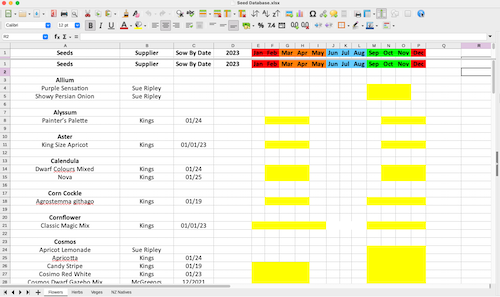
Once that is completed, it's time to browse the Kings Seeds catalogue. On the first go through I highlight all the things I need, and those that I want. I let myself go wild. After that is done, I knuckle down and make post it notes lists. This list is more focused, and I make a point of deciding things like if I do really need three different varieties of calendula...
After that, the next step is going onto the website. First of all I add stuff to the cart that we absolutely really need. After that I narrow down the other stuff I want and put it in the cart. Sometimes the seeds that I need and want appear in the Kings Seeds shopping rewards list (they have a system where after you spend a certain amount they give you free seed packets). Then I tend to juggle the cart based on if some of my seeds will end up on that list, there's no point wasting money on what will be free seeds.

After all that is done, and I've justified to myself every seed packet in the cart, it's time to pull out the credit card and pay for all my precious seeds. And then the waiting at the letterbox begins...it's nearly just as exciting sorting through all the new seed packets when they arrive.
Are you buying and growing any new varieties of plants this year in your garden? Do you have a seed database like I do? I'd be interested to find out.
Have a wonderful day
Julie-Ann
Want to discuss my post? Feel free to chat with me on Instagram or Mastodon.




